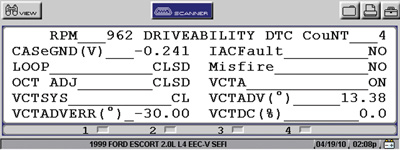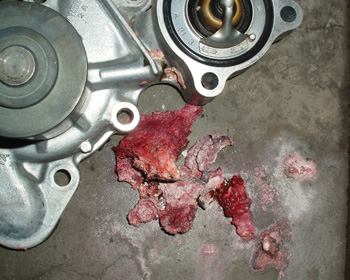 Since Pontiac introduced “rubber” timing belts with cogged teeth on its six-cylinder overhead camshaft engine during the late ’60s, anybody who’s made a living fixing cars has experienced the free-winding sound of a starter motor cranking an engine with a stripped timing belt.
Since Pontiac introduced “rubber” timing belts with cogged teeth on its six-cylinder overhead camshaft engine during the late ’60s, anybody who’s made a living fixing cars has experienced the free-winding sound of a starter motor cranking an engine with a stripped timing belt.
Back in the day, timing belt replacements were recommended for most engines around 60,000 miles. That interval was recently increased to 100,000 or more miles by many manufacturers to meet various state emissions mandates and to reduce maintenance needs.
While a lot has been written about timing belt replacement intervals, not a lot has been written about diagnosing timing belt and valve timing-related driveability complaints. Because a valve timing-related driveability problem is relatively rare, information about such problems has been difficult to collect.
But, because I’ve been doing more mobile diagnostics lately, I’m beginning to see more driveability problems caused by faulty valve timing. With those thoughts in mind, let’s take a look at how valve timing affects engine performance in this “Diagnostic Dilemma.”
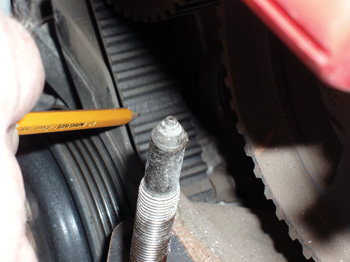 Intake Valve Timing
Intake Valve Timing
To understand how valve timing works in modern engines, let’s visualize a column of air moving through an intake port on a naturally aspirated engine. When the intake valve opens, a low pressure develops at the valve head that extends the column of air like an accordion through the length of the intake port.
When the valve closes, the moving column of air compresses like an accordion as it slams against the closed valve. At this point, the moving column of air creates a mild supercharging effect by building a slight amount of positive air
pressure in the intake port.
In general, there’s no significant air flow through a valve until it lifts about 0.050” off the valve seat. While effective lift might be less on a standard passenger car engine, the concept of effective lift generally dictates that the intake valve begins opening before TDC.
After TDC when the piston begins moving down in the cylinder, the valve is open far enough to allow air in the intake port to achieve maximum flow as the piston travels downward on the intake stroke. Because air velocity remains high in the intake port and continues to “pack” into the cylinder, the intake valve remains open until slightly after bottom-dead-center (BDC) to achieve optimum cylinder filling.
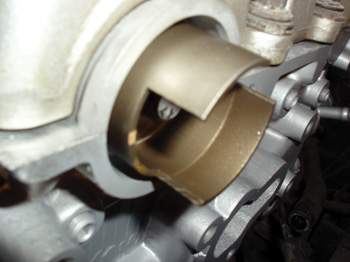 Keep in mind that valve opening and closing times are critical to engine performance. Advanced intake valve closing times tend to increase low speed compression and torque while retarded intake valve closing times tend to increase high-speed air flow. While exhaust valve timing isn’t as critical, changing the valve opening and closing times tend to produce similar results.
Keep in mind that valve opening and closing times are critical to engine performance. Advanced intake valve closing times tend to increase low speed compression and torque while retarded intake valve closing times tend to increase high-speed air flow. While exhaust valve timing isn’t as critical, changing the valve opening and closing times tend to produce similar results.
As we shall see later, variable camshaft timing systems on modern engines utilize these effects in combination with tuned intake manifolds to vastly improve the throttle response and performance of relatively small displacement engines.
Exhaust Valve Timing
Let’s look at exhaust valve timing as the piston travels from power to exhaust strokes. During the power stroke, most of the effective cylinder pressure dissipates as the piston approaches 45° after TDC and is nearly gone by the time the piston reaches 90° after TDC. For this reason, and because the valve needs to achieve effective lift, the exhaust valve begins relieving cylinder pressure by opening before BDC.
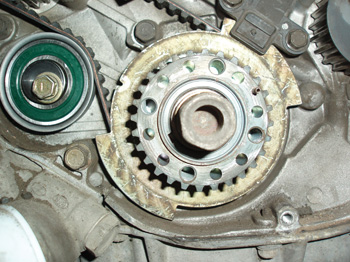 Keep in mind that exhaust valve opening times aren’t as critical as exhaust valve closing times. Exhaust valve opening simply releases pressure from the cylinder and allows exhaust gases to start flowing into the exhaust port.
Keep in mind that exhaust valve opening times aren’t as critical as exhaust valve closing times. Exhaust valve opening simply releases pressure from the cylinder and allows exhaust gases to start flowing into the exhaust port.
But exhaust closing times do have a great deal to do with fuel economy and power output. As the piston travels upward, the spent exhaust gasses achieve a very high velocity through the open exhaust valve and port. As the piston reaches TDC, this high velocity column of exhaust gas creates a slight negative pressure in the cylinder.
To optimize this negative pressure, the exhaust valve remains open at TDC. Because the intake valve is beginning to open at TDC, this creates a valve timing “overlap” condition between the intake and exhaust valves.
In short, the negative pressure formed in the exhaust port helps draw the intake mixture through the open intake valve. The exhaust valve must be held open long enough to effectively utilize this negative pressure, but not long enough to allow any portion of the intake mixture to flow out the exhaust port.
In summary, engineers improve air flow through naturally aspirated engines by manipulating valve opening, closing and overlap timing. The opening and closing times of the intake valves are critical to low- and high-speed performance. And last, the closing time of the exhaust valve is critical to initiating air flow into the cylinder when the piston is in the overlap position.
